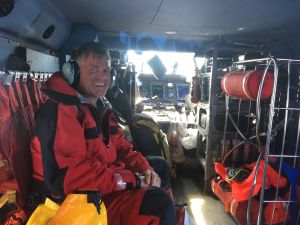The crew of a Coast Guard HH-60 Jayhawk helicopter from Air Station Cape Cod rescued an Austrian boater from a life raft in the Atlantic Ocean, approximately 120 nautical miles northeast of San Juan, Puerto Rico. Rescued is Wolfgang Sloma, 56, who was transiting aboard the 27-foot Austrian-flagged sailing vessel Daphni, when reportedly he was forced to deploy and board the vessel’s life raft after the mast partially broke and a hole in the hull caused the vessel to take on water and sink.
Coast Guard Sector San Juan watchstanders received a 406 MHZ Emergency Position Indicating Radio Beacon (EPIRB) distress signal from the Daphni, and immediately coordinated the HH-60 Jayhawk rescue helicopter from Air Station Cape Cod, launched from Air Station Borinquen, to search for the distressed boater. Coast Guard watchstanders also conducted Automated Mutual Assistance Vessel Rescue (AMVER) and Automatic Identification System (AIS) callouts to identify and notify commercial vessels transiting in the vicinity of the distress and contacted Vienna Rescue Control Center watchstanders in Austria, who confirmed having received a distress call from Sloma via satellite phone. Coast Guard watchstanders were able to contact Sloma and assess his condition aboard the life raft. Sloma reported he was wearing a life jacket and that his life raft was equipped with signaling flares, GPS, food, a VHF marine radio and a satellite phone.
The Coast Guard rescue helicopter and the KN Forest, a Singapore flagged cargo vessel that responded to the AMVER callout and had diverted to assist, arrived on scene with the distressed boater. The crew of the Coast Guard helicopter deployed their rescue swimmer, hoisted Sloma from the life raft and transported him to Air Station Borinquen in Puerto Rico, where he was assessed by Emergency Medical Service personnel and declined to receive any further medical care.
“This rescue speaks to the importance of having the right type of emergency equipment available during an open ocean voyage,” said Lt. Cmdr. Catherine Phillips, Sector San Juan Command Center Chief. “Our watchstanders quickly became aware of the distress and were able to establish communications with the boater and coordinate a successful rescue operation.” said Lt. Cmdr. Catherine Phillips, Sector San Juan Command Center chief.
Boating Safety Tips:
- Boaters are reminded to equip their vessels with safety equipment, be mindful of state boating laws, and be courteous to fellow boaters while operating on the water.
- There should be a personal flotation device on the vessel for each person, sized accordingly.
- Boaters should have flares and are encouraged to have an Emergency Position Indicating Radio Beacon (EPIRB) with 406 MHz capabilities to enable a faster response by the Coast Guard in the event of an emergency.
- Boaters should have an operational marine VHF radio on their boat in order to contact the Coast Guard on channel 16, in the event an emergency. The Coast Guard reminds radio operators that VHF channel 16 is an emergency channel and that improper transmission on channel 16 not only hampers Coast Guard response, but is punishable under federal law.
- The Coast Guard strongly recommends that all boaters file a float plan with a friend or family member on land, with an approximate time of return and location to which you will be heading. It is also recommended that you regularly check in with those who are aware of your plan, especially if your plan should change.
- Mariners should check current and forecasted weather conditions prior to getting underway, and remain aware of changing conditions once on the water. The National Weather Service broadcasts weather conditions throughout the day on VHF channel WX2. The Coast Guard broadcasts weather conditions on VHF channel 22A. Current weather information and advisories can be found on the National Weather Service website.












